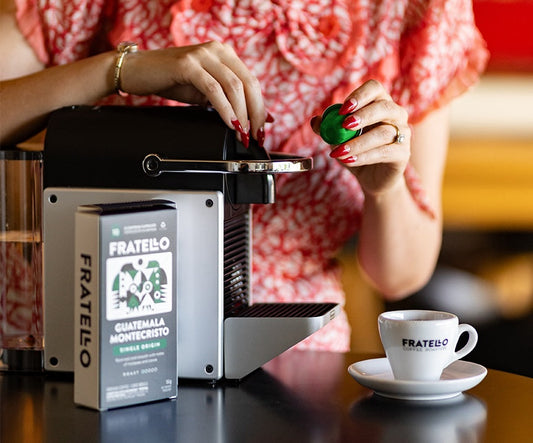Can Coffee be TOO Fresh? The Importance of Degassing Coffee

We’ve talked about the importance of fresh coffee ad nauseum here at Fratello Coffee. It’s coffee 101 to use up your beans within 2-4 weeks of roasting. But can coffee be too fresh? It may sound a little contradictory, but drinking too-fresh coffee can be less than tasty. This is where degassing coffee comes in.

In the coffee world, degassing is crucial after roasting. Coffee straight off the roaster can taste a bit jarring. Hardcore coffee lovers find extra-fresh coffee exciting, but the average coffee drinker will be a bit offput by the flavour.
Whether you make filter coffee at home or work in the coffee business, degassing coffee is key to making tasty coffee. Let’s take a look at the composition of fresh coffee and explore why it’s so important to give coffee a rest.
Why degassing coffee is necessary
When coffee beans are being roasted, the beans produce and trap carbon dioxide. Most of the CO2 dissipates from the coffee while it’s being roasted, but the coffee will retain a significant amount of it. CO2 is a natural byproduct of roasted coffee, but in large amounts, it can make the coffee taste bad. Extra fresh coffee will have a sour, vegetal, even carbonated taste. This can distract from the desirable flavour notes of the bean.
After roasting, experts in the coffee industry recommend you rest, or “age”, your coffee for a few days before brewing. Lighter roasted beans are denser, and therefore retain a lot more CO2 than darker roasts. The lighter the roast, the longer it needs to rest.
There will still be CO2 in coffee even after the coffee has rested, but in smaller amounts. Have you ever wondered why pour over recipes tell you to “bloom” your coffee? It’s because pouring a bit of hot water on the grinds allows the gasses to dissipate, improving the flavour of the coffee.
Does aged coffee make a better espresso?
While degassing is important no matter what method you’re using, it’s particularly important for espresso. Because espresso introduces pressure, it’s a lot easier for those gasses to end up in the shot, altering the flavour. And, because third-wave espresso bars tend to serve light and medium roast espresso, aging is crucial.
Giving the coffee time to degas will let you taste the true characteristics of the coffee. You won’t have that overpowering CO2 flavour distracting your taste buds.
It’s important to realize that the “crema” layer (the caramel-coloured layer on top of the espresso) is overrated. While it may look delicious and make stunning latte art, it can make a bitter tasting drink. An ultra-thick crema layer indicates right away that your beans are still too fresh. Aging the coffee will make for a thinner crema layer, but the flavour will be much better.
How to degas coffee after roasting
Degassing coffee is simply a question of resting the coffee and leaving it alone for a few days. There’s no special technique–just let it sit undisturbed with minimal exposure to light, heat, and moisture. It should be left in an opaque container with a clearly-marked roast date so you know when to start using it.
How long should I degas the coffee?
How long you age your coffee depends on two things: the brew method you’re using, and the roast level.
When it comes to drip or filter coffee, it’s a good idea to rest your coffee for 2-8 days before using it. Lighter roasts can rest for 4-8 days, and darker roasts can rest for 2-4 days.
When it comes to espresso, you’ll want to wait longer. If you’re using a light roast, you’ll want to rest the coffee for 10 days. If you’re using a medium roast, rest it for 8-10 days. If you’re using a dark roast for your espresso, it should only rest for about 2 days. Dark roast coffees are porous, and you should be more concerned about using them up before they go stale.
For further information on coffee storage, please refer to our blog post: 5 Ways to Keep your Beans Fresh
How can I degas coffee quickly?
We don’t recommend trying to speed up the degassing process. If you try to prematurely degas the coffee by exposing it to air and light, you’ll only damage it and make it go stale. Have patience!
If you run an espresso bar and you want to serve perfectly aged coffee at all times, do a bit of planning. It’s a good idea to have extra stock of your most popular espresso blend so you don’t have to wait for it to degas.

What’s the point of the degassing valve?
On most coffee bags, you’ll see a circle with holes. That’s the degassing valve. While most people think that’s some kind of gadget for smelling the coffee, it actually serves a very important, practical purpose. It stops the bag of beans from exploding!
Freshly roasted beans contain enough CO2 to puff, and even explode, the bag. The valve is a one-way channel, letting CO2 exit without allowing outside air to enter the bag.
The purpose of degassing valves became abundantly clear after a 2019 incident with a popular California roaster. The renowned Blue Bottle Coffee had to recall their coffee, which was packed in airtight tins, after 13 people were injured.
Fresh to death
Degassing your coffee is a great tool to have in your back pocket if you run an espresso bar. It’s a system you can implement early on to take your espresso from good to great. When it comes to making great coffee, there’s no one single recipe for perfection. Making great coffee requires curiosity, and it’s a journey of learning as you go.
If you’re looking to improve your overall espresso game, check out our previous post about pulling a perfect shot of espresso. If you’re in the coffee business and need more support, book a consultation with us by dropping us a line at info@fratellocoffee.com.






